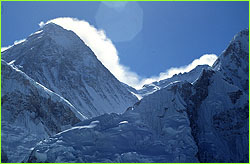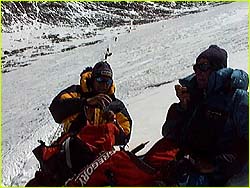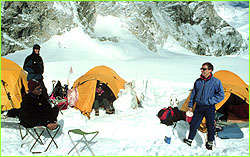 |
 |
 |
 Higher than Everest?
Higher than Everest?by Tom Hornbein, M.D. Mount Everest, standing over 29,000 feet above the surface of the sea, is the highest point on earth on which a human can walk. As such, the challenge of reaching this so-called "Third Pole" was a dream of explorers and mountaineers from the moment it was first identified as the highest point in the world. When I was in my teens, Everest had not yet been climbed. Because the air at the summit is so thin, with about a third the oxygen pressure available at sea level, many people wondered whether it was possible to reach its summit, even using bottled oxygen, and to survive at the summit without this aid. Some physiologists opined, extrapolating from measurements obtained somewhat lower down, that at the top of Everest even an acclimatized person would be incapable of any work, perhaps including even the work of breathing very hard; that all a climber could do is stand and pant, or perhaps only lie down and pant. The first ascent of Everest in 1953 by Edmund Hillary and Tenzing Norgay proved that acclimatized humans could indeed stand upon the summit without collapsing. In 1978 Peter Habeler and Reinhold Messner climbed Everest without the use of supplemental oxygen, demonstrating that we humans, at least some among us, could do a bit more than just stand and pant at the top of the world. I am reminded of my teachings as a medical student, when physiologists had calculated that humans could not run a mile in under four minutes; one year later Roger Bannister proved them wrong. If you or I were to ascend quickly to 29,000 feet, like the British and French balloonists in the late 19th century, we would become unconscious within a couple of minutes and would perish soon thereafter. This rapid failure is in stark contrast to the performance of climbers after several weeks of gradual ascent to high altitude. This remarkable transition is termed adaptation or acclimatization. Acclimatization to high altitude involves changes in breathing, in the ability of the blood to transport oxygen from our lungs to cells within critical organs, despite the much lower pressure of oxygen in the air we breath. One of the body's first responses to going to high altitude is an increase in breathing. This change begins almost instantly and continues to increase over just a few days. Increased breathing raises the pressure of oxygen in the lungs, which allows more oxygen to be carried in the blood to vital organs like the brain and muscles, none of which can survive without a continuous supply of this essential gas. Among the ways of getting more oxygen to the brain, the muscles (including the all-important heart muscle which pumps the blood) and our other organs is to increase the flow of blood to these organs and also to increase the ability of the blood to carry oxygen. The brain appears to be one organ whose blood flow is protected even after just a day or two at high altitude. And over many days to a few weeks the body makes more red blood cells, the cells that contain the hemoglobin that binds oxygen in the lungs and provides its transport to the organs in our body. Also the cells within those organs appear to undergo adaptations of their own that enable function to continue even when the pressure of oxygen coming to them is appreciably lower than when we are at sea level.  We know now that us human earthlings, once acclimatized, can climb to the
summit of Everest without the use of supplemental oxygen, at least a few
exceptional people can. While we have made some observations about the
characteristics of those who have done so, putting a finger on precisely how
they are different is not so easy. Those who live permanently at high altitude
near Everest may have special attributes of lung function and other
physiological differences. Most, but interestingly not all, of the more able
lowlanders have a higher than average breathing response to the stimulus of low
oxygen. Although some also have high aerobic capacity, including the ability
of the heart to pump large volumes of blood, climbing at extreme altitude is
slow. Because the maximum work capacity is only one quarter to one third of what it is at
sea level, demands upon the cardiovascular system are not great. Therefore the high work
capacity (VO2max) of the endurance athlete seems
not to be an essential attribute.
We know now that us human earthlings, once acclimatized, can climb to the
summit of Everest without the use of supplemental oxygen, at least a few
exceptional people can. While we have made some observations about the
characteristics of those who have done so, putting a finger on precisely how
they are different is not so easy. Those who live permanently at high altitude
near Everest may have special attributes of lung function and other
physiological differences. Most, but interestingly not all, of the more able
lowlanders have a higher than average breathing response to the stimulus of low
oxygen. Although some also have high aerobic capacity, including the ability
of the heart to pump large volumes of blood, climbing at extreme altitude is
slow. Because the maximum work capacity is only one quarter to one third of what it is at
sea level, demands upon the cardiovascular system are not great. Therefore the high work
capacity (VO2max) of the endurance athlete seems
not to be an essential attribute.Because the partial pressure of oxygen in the blood is so low, one of the bottlenecks to moving oxygen from air to organs seems to be a limitation of diffusion of that precious gas from the lung alveoli into pulmonary capillaries and perhaps also from tissue capillaries to the mitochondria of cells. When one works harder at extremely high altitude, blood passes more rapidly through lung capillaries; the time available for oxygen to move from lung into the blood is shortened. So, at the summit of Everest, when a climber exerts a little too much without supplemental oxygen, the blood oxygen concentration falls, vision may dim, and effort slow, sort of like having a governor on a car's motor to keep it from going too fast. All these observations have led to the feeling that the summit of Mount Everest is fortuitously just as high as an acclimatized human being can go and survive without breathing supplemental oxygen; or to put it another way, if Everest were a 1000 feet higher, the physiologic challenge would be beyond the capacities of even the most exceptional among us. Another hint that Everest is close to the limit for us humans is that studies of climbers returning from high altitudes indicate that some have evidence of mild, transient brain injury. Those individuals have problems remembering and recalling new information, or show confused thinking, or have trouble performing rapid fine muscle tasks such as finger-tapping. These changes represent one more possible hazard of climbing Mount Everest, along with all the more obvious risks involved in mountain climbing at the upper end of the earth. So, is Everest as high as man can go? I personally am convinced that it is not, but it must be very close, even for those who seem to perform most exceptionally up there. How much higher might a human go? Not wanting to fall into the physiologic trap of seeing my predictions miss the mark, I'll resist the urge to guess. But the observation of atmospheric pressure on the summit on May 23 provides the opportunity to speculate. If the value of 259.5 mm Hg that David Breashears obtained on May 23 is confirmed once the barometer's calibration is checked by Professor John West at the University of California, San Diego, it is about 6.5 mm Hg higher than the value obtained by Dr. Chris Pizzo in the same location in the fall of 1981. This difference is compatible  with a seasonal variation, implying
that oxygenless ascents would be easier in the spring than the fall.
Indeed the difference is worth about 600 to 900 feet of altitude. So, at the right time of year,
might a 30,000-foot high mountain be within our capabilities?
with a seasonal variation, implying
that oxygenless ascents would be easier in the spring than the fall.
Indeed the difference is worth about 600 to 900 feet of altitude. So, at the right time of year,
might a 30,000-foot high mountain be within our capabilities?Until we learn to walk on air, or last out the millennia as the highest mountain is slowly uplifted to yet greater heights by the tectonic plate migrating northward below, we will not know. With Roger Bilham's estimate that this part of the Himalaya is being pushed up maybe 3 to 5 millimeters a year, in a mere 100,000 years, assuming no wear-and-tear from the tread of human feet and other causes, Everest will be a 1000 feet higher than it is now. Will it become physiologically out of reach except by using supplemental oxygen? Perhaps. But who knows what sort of humanoids will be seeking the highest point on earth by then? Or why? On May 22, 1963, Tom Hornbein and his companion, Willi Unsoeld, reached the summit of Everest by way of the West Ridge, then completed the first traverse of the mountain by descending the side on which our NOVA story has unfolded Dr. Hornbein is currently Professor of Anesthesiology and Physiology and Biophysics at the University of Washington in Seattle. Photos: (1) Liesl Clark; (2) Pete Athans; (3) David Breashears. Lost on Everest | High Exposure | Climb | History & Culture | Earth, Wind, & Ice E-mail | Previous Expeditions | Resources | Site Map | Everest Home Editor's Picks | Previous Sites | Join Us/E-mail | TV/Web Schedule About NOVA | Teachers | Site Map | Shop | Jobs | Search | To print PBS Online | NOVA Online | WGBH © | Updated November 2000 |